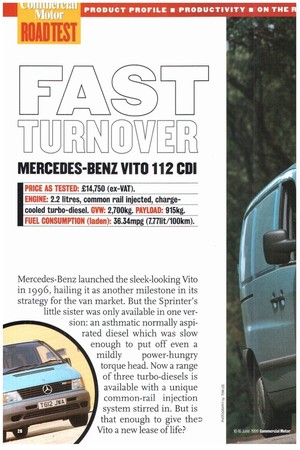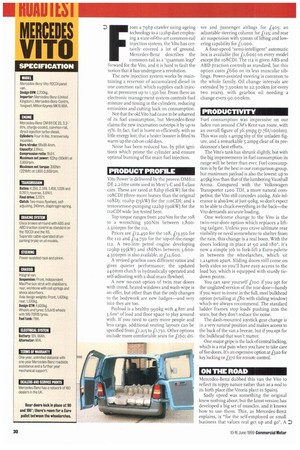MERCEDES-BENZ VITO 112 CM
Page 30

Page 32

Page 34

If you've noticed an error in this article please click here to report it so we can fix it.
',PRICE AS TESTED: £14,750 (ex-VAT). ',PRICE AS TESTED: £14,750 (ex-VAT). ENGINE: 2.2 litres, common rail injected, chargecooled turbo-diesel. Mt 2,700kg. PAYLOAD: 915kg. FUEL CONSUMPTION (laden): 36.34mpg (7.7711t/100km). Mercedes-Benz launched the sleek-looking Vito in 1996, hailing it as another milestone in its
strategy for the van market. But the Sprinter's little sister was only available in one ver sion: an asthmatic normally aspi rated diesel which was slow enough to put off even a mildly power-hungry torque head. Now a range of three turbo-diesels is available with a unique common-rail injection system stirred in. But is that enough to give theo Vito a new lease of life?
D rom a 79hp crawler using ageing
technology to a 122hp dart employing a state-of-the-art common-rail injection system, the Vito has certainly covered a lot of ground. Mercedes-Benz describes the common-rail as a "quantum leap" forward for the Vito, and it is hard to fault the notion that it has undergone a revolution.
The new injection system works by maintaining a reservoir of accumulated diesel in one common rail, which supplies each injector at pressures up to 1,350 bar. From there an electronic management system controls fuel mixture and timing in the cylinders, reducing emissions and cutting back on consumption.
Not that the old Vito had cause to be ashamed of its fuel consumption, but Mercedes-Benz claims the new incarnation outstrips it by up to 15%. In fact, fuel is burnt so efficiently, with so little energy lost, that a heater booster is fitted to warm up the cab on cold days.
Noise has been reduced too, by pilot ignitions which prime the cylinder and ensure optimal burning of the main fuel injection.
PRODUCT PROFILE
Vito Power is delivered by the proven 0M6ii DE 2.2-litre units used in Merc's C and E-class cars. These are rated at 82hp (6okVV) for the ro8CDI (three more horses than the original ro8D); ro2hp (75kW) for the iroCDI; and a testosterone-pumping 122hp (9okW) for the tr2CDI wide boy tested here.
Top torque ranges from 200Nm for the ro8 to a wrenching 300Nm between 1,8002,500rpm for the 112.
Prices are /12,450 for the ro8, £13,350 for the iro and /14,750 for the top-of-the-range 112. A two-litre petrol engine developing 129hp (95kW) and 186Nm between 3,6004,5oorpm is also available, at £12,600.
A revised gearbox uses different ratios and gives quieter performance; the updated 240mm clutch is hydraulically operated and self-adjusting with a dual-mass flywheel.
A new no-cost option of twin rear doors with tinted, heated windows and wash-wipe is on offer, but other than that the only changes to the bodywork are new badges—and very nice they are too.
Payload is a healthy 990kg with 4.8m and 3.6m2 of load and floor space to play around with. If you need to carry more people and less cargo, additional seating layouts can be specified from 14,215 to £1,750. Other options include more comfortable seats for £160; dri ver and passenger airbags for £405; an adjustable steering column for £125; and rear air suspension with 5omm of lifting and lowering capability for £1,000.
A four-speed "semi-intelligent" automatic box is available (for /1,600) on every model except the ro8CDI. The 112 is given ABS and ABD (traction control) as standard, but this option costs /660 on its less muscular siblings. Power-assisted steering is common to the whole family. Oil change intervals are extended by 7,500km to 22,500km (or every two years), with gearbox oil needing a change every 90,0ookm.
PRODUCTIVITY
Fuel consumption was impressive on our laden run around CM's Kent van route, with an overall figure of 36.3mpg (7.71it/iookm). This was only 1.4mpg shy of the unladen figure, and a remarkable 5.mpg clear of its predecessor's best efforts.
The Vito's tank has shrunk slightly, but with the big improvements in fuel consumption its range will be better than ever. Fuel consumption is by far the best in our comparison group, but maximum payload is also the lowest: up to 405kg less than that of the lumbering Vauxhall Arena. Compared with the Volkswagen Transporter 1200 TDI, a more natural competitor, the Vito still concedes 200kg. Axle tolerance is also low, at just 90kg, so don't expect to be able to chuck everything in the back—the Vito demands accurate loading.
One welcome change to the Vito is the twin-rear-door option which replaces a lifting tailgate. Unless you crave ultimate rear visibility or need somewhere to shelter from the rain, this change is a real boon. With the doors locking in place at 90 and 18o°, it's now a simple job to fork-lift a Euro-palette in between the wheelarches, which sit 1,214mm apart. Sliding doors still come on both sides so you'll have easy access to the load bay, which is equipped with sturdy tiedown points.
You can save yourself Poo if you opt for the unglazed version of the rear door—handy if you want to invest in the full, steel bulkhead option (retailing at /8o with sliding window) which we always recommend. The standard ladder frames stop loads pushing into the seats, but they don't reduce the noise.
The dash-mounted joystick gear change is in a very natural position and makes access to the back of the van a breeze, but if you opt for the bulkhead that won't matter.
One major gripe is the lack of central locking, which is a real pain when you have to take care of five doors. It's an expensive option at £320 for key locking or £370 for remote control.
ON THE ROAD
Mercedes-Benz dubbed this van the Vito to reflect its nippy nature rather than as a nod to its birth place (the Vitoria plant in Spain).
Sadly speed was something the original knew nothing about, but the latest version has developed a big set of muscles, and it knows how to use them. This, as Mercedes-Benz explains, is "for the self-employed or small business that values real get up and go". A
D Saharan Mr Whippy making a dash for the next cool oasis, perhaps?
The Vito ii2CDI hits 80km/h in just under 12 seconds; its scrawny predecessor only managing the same target after 20 seconds had ticked by. Only the VW Transporter comes close to this figure, with a time of 15.8 seconds for the headlong dash to 8okm/h, but then it has 34hp less to get it there.
Progress through the gears is swift, with positive, easy changing from the dashmounted lever which uses a cable system to shift the cogs.
Given the Vito's performance potential it's comforting to have assured handling, whether its coping with cross winds at high speeds on the motorway, or accelerating away from a roundabout off camber. There's plenty of feel through the power steering, which is well able to rein in the power and give a precise feel around town_ The ride is very comfortable—a little softer than the Transporter on the front, with some bobbing over bumps when carrying a full load. The lean around corners gave no cause for concern, and the turning-circle radius is also very good at just io.65m between kerbs. Braking is another story. The ri2CDI comes with ABS and a traction control system called ABD as standard—which is nice. Unfortunately we didn't know our
early version wasn't equipped with the system, so we got some interesting results when we stamped on the brakes at 40mph and expected to steer. Despite this little hitch our results were very good at the track, even if we did lose a lot of rubber to the asphalt in some long, straight skids. Take our findings with a pinch of salt and expect better tyre wear with more judicious use of the pedal!
CAB COMFORT
The asymmetrical dash has been given an overhaul for 1999, with new plastics and dials to toy with. Comfortable and supportive seats are fitted with new cloth trim and an extra 24mm of fore/aft travel adjustment. The steering wheel is still neither reach nor height adjustable as standard: it ought to be.
Visibility from the driver's seat is good, if slightly marred by the twin doors, but we wonder how much it would cost to add a blind-spot device to the wing mirrors. Cab noise was acceptable in our test, although the rubber load mat in our test vehicle (yours for 1rI5) might have soaked up a little noise.
A standard RDS radio/cassette has a lot of power behind it for all conditions but, annoyingly, has only fast forward; no rewind. Buttons on the sound system are within easy reach and ergonomic so drivers can feel their way around rather than taking their eyes off the road. Mind you, it's all too easy to change stations when changing into fifth, as the gear lever sits just behind the radio on the console. Most of the other switches are within easy distance of the driver's seat, but it is a bit of a stretch to reach the temperature control for the blower.
Ventilation and heating are good, with efficient, quiet operation on the first two settings of the new knurled wheel selector.
Storage continues to be lacking in the cab; a cup holder is a notable omission. Side pockets in the doors are narrow and good only for paperwork, while two better sized holes on the passenger side could really do with being turned into a glovebox by the addition of a cover. Buyers can specify a centre console with drinks holder, cassette storage and oddments tray for fg I.
The cigarette lighter/mobile phone charger is still hidden away in the ashtray, which feels as if it would give way under the weight of a phone (or a hefty cigar). But other than the ashtray, the whole cab feels rock solid with no sign of squeaks or rattles.
SUMMARY
It may come as no surprise to discover that it's difficult to find fault with the new Vito. While a few original niggles remain, fundamental gripes over lack of power and choice are more than tackled by the new commonrail engines_ And there's no penalty at the pump either.
Some might argue that a van simply doesn't need to be as fast as the rt2CDI, but it's always nice to have the choice. And MercedesBenz has ensured that the Vito is not just an out-of-control teenager of a van, giving it a drive that is assured, confident and mature.
Talk of the Vito as the little sister of the Mercedes-Benz range somehow understates what has happened to this van. The Vito hasn't so much grown up as undergone a complete metamorphosis under the skin.
• by Peter Lawton












































































































